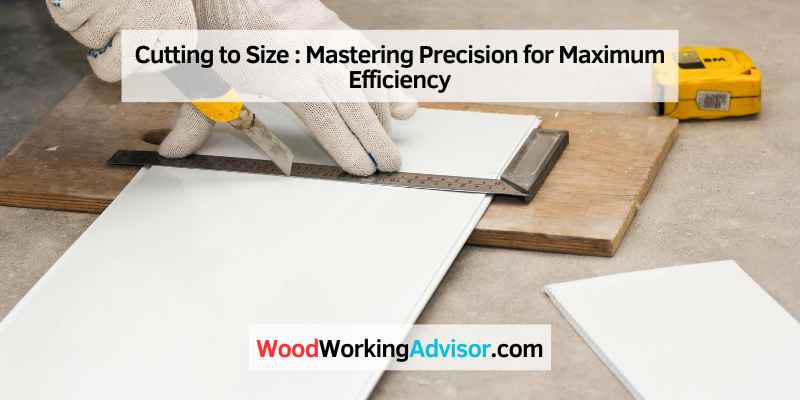Cutting to size involves trimming a material to fit specific dimensions accurately for a project. Precision is crucial for achieving the desired outcome and ensuring proper functionality.
When starting a DIY project or working in a fabrication workshop, cutting materials to the correct size is a fundamental step. Whether it’s wood, metal, plastic, or any other material, getting the dimensions right is essential for the project’s success.
By using the appropriate tools and techniques, you can achieve precise cuts that will result in a professional-looking and functional end product. Understanding the basics of cutting to size, including measurements, tools, and safety precautions, is key to mastering this crucial aspect of working with materials. In this guide, we will explore the importance of accurate cutting, the different methods and tools available, and some tips for achieving precise cuts in your projects.

Credit: www.smetals.co.uk
Importance Of Precision Cutting
The precision cutting process is crucial for any project to ensure accuracy
Ensuring Accuracy
. Aiming for exact measurements guarantees a perfect fit.
Maximizing Efficiency
It is vital for saving resources and time. Incorrect cuts can lead to material wastage and project delays.
By upholding high precision standards, you reduce errors and rework issues. Each cut must be on point to maintain consistency. Quality results rely on precise cutting techniques.
Tools For Precision Cutting
Precision cutting is essential in various DIY projects and professional tasks. To achieve accurate results, it is crucial to use the right tools and techniques. Understanding the tools for precision cutting can make your cutting to size tasks efficient and precise.
Choosing The Right Equipment
- Consider the material: Select a cutting tool suitable for the material you are working with, such as wood, metal, or plastic.
- Accuracy: Opt for tools that offer precise cutting capabilities to ensure clean and smooth cuts.
- Comfort and control: Choose tools that are comfortable to hold and provide you with the control needed for accurate cutting.
Understanding Blade Types
- Diamond Blades: Ideal for cutting hard materials like concrete and stone.
- Carbide-Tipped Blades: Suitable for cutting abrasive materials like metal and masonry.
- High-Speed Steel Blades: Great for cutting through softer materials like wood and plastic.
Techniques For Precision Cutting
When it comes to precision cutting, employing the right techniques is instrumental in achieving accurate and clean cuts. Whether you are working on wood, metal, or other materials, mastering the art of precision cutting is essential for a flawless end result. This section will cover essential techniques for precision cutting, focusing on measuring and marking, as well as utilizing cutting guides.
Measuring And Marking
Measuring and marking are the foundational steps for precision cutting. Accurate measurements and markings ensure that the material is cut to the exact specifications required for the project. Utilizing a high-quality measuring tape, square, or ruler, carefully measure and mark the material using a pencil or marking knife. Double-checking the measurements before cutting is crucial to avoid errors.
Utilizing Cutting Guides
Cutting guides provide a consistent and accurate way to guide the cutting tool along the material. Whether using a straight edge for linear cuts or a circular cutting guide for curved cuts, these tools help maintain precision and reduce the risk of errors. When using cutting guides, secure them in place to prevent any movement during the cutting process, ensuring a smooth and precise cut.
Common Challenges And Solutions
One of the challenges when cutting to size is achieving precision and accuracy, which can be especially difficult with certain materials. However, utilizing advanced cutting tools and techniques, such as laser cutting or waterjet cutting, can provide efficient and precise solutions to this issue, ensuring clean and accurate cuts for various materials.
When it comes to cutting materials to size, there are several common challenges that can arise. These challenges can range from selecting the right material for the job to ensuring accuracy in the cutting process. In this section, we will explore these challenges and provide solutions to help you overcome them.
Material Considerations
One of the primary challenges in cutting materials to size is selecting the right material for the job. Different materials require different cutting methods and tools. Moreover, the thickness and density of the material must be taken into account.
To ensure accurate cuts, it is essential to consider the material’s properties and choose the appropriate cutting method accordingly. For example, with a dense material like hardwood, using a saw might be the best option, while a lighter material like foam may require a different approach, such as a hot wire cutter.
Preventing Inaccuracies
Accurate cutting is crucial for a successful project. Inaccuracies can result in wasted materials, additional costs, and compromised quality. To prevent inaccuracies, attention to detail and proper techniques are key.
One common solution is to mark the cut line on the material before cutting. This can be done using a pencil, ruler, or other marking tools. Taking the time to make precise measurements and markings will help ensure the accuracy of your cuts.
Additionally, using the right cutting tools and equipment is vital for achieving precise results. A sharp blade or tool is less likely to cause deviations or irregular edges. Regularly maintaining and sharpening your cutting tools will help maintain their accuracy.
In some cases, it might be necessary to use guides or jigs to assist with the cutting process. These tools can help maintain straight lines and angles, reducing the risk of human error. Investing in high-quality guides or jigs can be a valuable long-term solution.
Lastly, practicing and honing your cutting skills can make a significant difference in the accuracy of your cuts. Taking the time to improve your technique and familiarity with the tools you use will contribute to better results.
Mastering Precision Cutting
Discover the art of precision cutting, a crucial skill in crafting materials to the perfect size with expert finesse. Learn the techniques needed to achieve accurate and clean cuts for a professional finish in your projects. Mastering precision cutting elevates your craftsmanship to new heights.
Mastering Precision Cutting
Many crafts and DIY projects require precise cutting to achieve the desired outcome. Whether you are a professional woodworker or just starting out as a hobbyist, mastering precision cutting is essential. With practice and patience, along with proper maintenance and sharpening techniques, you can become a skilled craftsman capable of cutting to size with precision and accuracy.
Practice and Patience
Practice makes perfect, and precision cutting is no exception. It takes time to develop the skills needed to make accurate and clean cuts. The more you practice, the better you will become at handling your tools and determining the right angles and measurements. Start with simpler projects and gradually work your way up to more complex ones. With each project, take the time to focus on your cutting technique and make adjustments as needed.
Maintaining a steady hand is crucial when it comes to precision cutting. By practicing your grip and posture, you can ensure that your hand and tools are steady throughout the cutting process. Taking breaks during long sessions will help you maintain focus and prevent fatigue, which can lead to mistakes. Remember, precision cutting requires attention to detail and a calm and patient mindset.
Maintenance and Sharpening
To achieve precision cuts, it is essential to keep your cutting tools in good condition. Regular maintenance and sharpening will ensure that your tools are always ready for use. Clean your tools after each use to remove any debris or buildup that can affect their performance. Proper storage is also important to prevent damage or dulling.
Sharpening your cutting tools regularly will keep them sharp and effective. Invest in sharpening tools or seek professional help to maintain the sharpness of your blades. Dull blades can lead to imprecise cuts, so it is essential to stay on top of their maintenance. Additionally, inspect your blades for any signs of wear or damage, and replace them if necessary.
By mastering precision cutting, you will be able to elevate your craft projects and achieve professional-looking results. With practice, patience, and proper maintenance, your skills will continue to improve, allowing you to take on more challenging projects with confidence. Enjoy the journey of honing your precision cutting skills and watch as your creations come to life with accuracy and finesse.

Credit: tikweld.com
Frequently Asked Questions Of Cutting To Size
How Can I Cut A Large Sheet Of Material To The Desired Size?
Cutting a large sheet of material to the desired size can be done using various tools such as a circular saw, jigsaw, or table saw. Measure and mark the desired dimensions on the material, then carefully follow your marked lines with the chosen tool.
Take proper safety precautions and use a steady hand for accurate cuts.
What Are Some Common Mistakes To Avoid When Cutting Materials?
Some common mistakes to avoid when cutting materials include rushing the process, using the wrong tool for the material, not measuring accurately, and not holding the material securely. Take your time, choose the right tool for the job, double-check your measurements, and always ensure the material is properly secured before making any cuts.
How Do I Minimize Waste When Cutting Materials To Size?
To minimize waste when cutting materials to size, plan your cuts carefully to make the most efficient use of the material. Measure and mark accurately, and consider how you can arrange your cuts to minimize leftover scraps. Additionally, if feasible, consider using a computer-controlled cutting machine that can optimize the cutting layout for minimum waste.
What Safety Precautions Should I Take When Cutting Materials?
When cutting materials, always wear appropriate safety gear such as safety goggles, gloves, and ear protection if necessary. Make sure you have a clear workspace, free from clutter or potential hazards. Follow the safety guidelines for the specific tool you are using, and take your time to ensure each cut is made safely and accurately.
Conclusion
Cutting materials to the right size is crucial for various industries. By understanding the factors and techniques involved, businesses can optimize their operations and enhance productivity. Choosing the right cutting tools and methods is essential for achieving precision and efficiency in manufacturing processes.
Stay updated on the latest advancements to streamline your cutting operations effectively.


